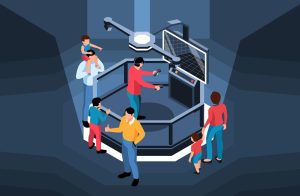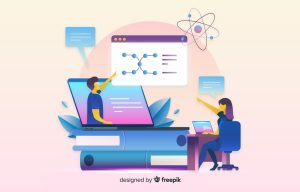4 Ways AI Is Reshaping the Graphic Design Landscape

2019 is the year when the AI hype is all over the place. Once thought to be just a work of science fiction, AI is now ubiquitous. Every industry is now embracing the power of artificial intelligence more than ever before. It can be used to speed up processes and take over the busy work in multiple industries.
In healthcare, AI solutions can outperform humans in diagnosing disease, especially malignant tumors. Whereas in marketing, AI can analyze user’s behavior patterns helping businesses target customers with efficient personalized marketing tactics. The graphic design sector is no exception to the industries where AI is making huge strides.
For today’s designers, the power of AI represents a serious business chance. That is why designers should pay a lot of attention to the effects and implications of today’s AI revolution in this sector and what value it can bring on the table.
According to IBISWorld, in 2019, the total revenue of the US graphic design industry accounted for $15 billion. Moreover, data from 99 Designs shows that 67% of small businesses believe that the importance of graphic design to business success will significantly grow in the next five years.
So, considering that artificial intelligence is joining the graphic design sector at full force these days, how will it reshape the design landscape over the years to come?
Image source: https://unsplash.com/photos/o2TRWThve_I
1. Can AI create art?
Absolutely! While the early AI had very limited functions and features, contemporary AI can even create artworks. Not long ago this year, we have witnessed that algorithms can be impressive painters when a new algorithm developed by researcher Mauro Martino created portraits entirely from scratch.
As surprising as it may be, the AI Portrait Ars doesn’t just remix previous paintings it has learned into something new but it is rather inspired by pictures of real humans to create portraits from the scratch.
But if AI can now create art, how can it bring its contribution to the graphic design landscape? Although experts believe that creativity is not a precisely identifiable humane capability that they can make the machines learn about, AI tools seem to have evolved so much over the past decade that they can at least imitate something close to what creativity is in humans.
The best way to understand this is by considering the example of Nutella’s marketing campaign in Italy. Combining the capabilities of artificial intelligence in design and marketing, the company generated and printed 7 million one-of-a-kind images for jar designs that they have sold in their Italian market in less than 30 days.
2. Automated problem solving
Graphic design may seem nothing like math if you consider its artistic side. However, there is a multitude of processes that are closer to what math looks like rather than the creative creation of content. We are talking about statistics, data processing, and knowledge science that are all brought to the table. So, sometimes, the job of a designer includes a lot of problem-solving work from correcting and resizing images to cropping assets.
These types of tasks used to require the human eye intervention that is capable of paying attention to details. However, today’s evolved artificial intelligence can automate some of the problem-solving tasks, thus, allowing designers to spend more time on more important product decisions.
As Dorian Johnson, a marketing specialist at WoWGrade, explains “In marketing, graphic design represents more than just pictures or illustrations. It is rather a fantastic combination of words, numbers, colors, fonts, and photographs that help businesses promote their products or services in a creative way.” So, since creating an efficient graphic design involves a multitude of tasks and factors, using AI to automate some of these tasks is certainly a relief for designers.
For example, Adobe developed a new AI tool called Sensei which is capable to identify image patterns while it edits or patches an image. Moreover, Sensei is also capable of reinventing, from scratch, a specific image. Other examples would be Netflix’s automatic translation AI tool which can expedite content localization or Airbnb’s AI tool which can detect and transform paper sketches created by designers into codes in real-time.
3. User experience personalization
In today’s business landscape, user and customer experience are paramount. And, since websites are one of the most important parts of any business’s online presence, websites have become more sharp-witted these days. Today’s websites are built based on a multitude of user data to provide a tailored experience for each visitor. From considering the best time of the day for the user to access the site to the type of devices they prefer to use, these are all relevant aspects that contribute to creating a personalized user experience.
However, this hard work of precise decision making based on huge amounts of data used to be manually done by designers, together with strategists and IT experts, until a few years ago. Today, AI has the capability to analyze data and transform it into more scalable and highly-personalized use cases. That being said, AI can help designers enhance personalization in user experience by translating complicated data into relevant and easier to understand facts.
When it comes to web design, AI is reshaping the entire sector and the way in which it was able to offer a good user experience. Today, conversational interfaces that facilitate human-computer communication make a popular trend among the AI and design communities. Chatbots and voice assistants can provide users with support by helping them find the answers to the most basic questions they have when visiting a website.
4. Generative and dynamic visual styles
The job of a designer isn’t simple when it comes to creating generative and effective visual styles. However, the good news is that today’s AI capabilities can help with this one too.
For example, different instruments like Prisma or Artisto can identify image content, be it the face of a human or a fruit, and applies smart filters to the image based on what it recognizes to add the finest visual effects.
What is even more surprising about the capabilities of contemporary AI is the fact that it can learn and predict what the designer wants to create. The more designers engage with machine learning tools for drawing sketches, the better AI can understand and predict what the users are drawing.
Can today’s AI design multiple websites on its own? There is another fascinating example that proves that it can. In 2014, a company named The Grid created a crowdfunding campaign with an AI named Molly. The web designer AI molly was capable of helping websites to create their own design. The results: a multitude of successful websites and no missed deadline.
Moreover, the main current functionality of the AI Molly is to auto-crop images and generate color palettes having the capability to generate over 200.000 different designs from only a basic five-color palette.
Design surrounds us everywhere from the newspaper we used to read years ago in the morning to the websites we access today or the mobile apps we use on a daily basis. Yet, thanks to today’s AI, designers will increasingly use its power to facilitate their work into creating more engaging and user-friendly graphic design projects.





